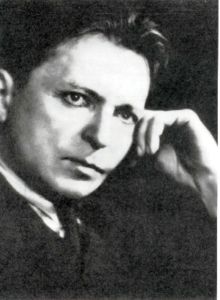 |
 (1881–1955) |

|
 |
b. Aug. 19, 1881, Liveni, near Dorohoi, Romania d. May 4, 1955, Paris, France "The violinist and composer George Enescu (known in France as Georges Enesco) is considered one of Romania's greatest musicians. He was especially known for his interpretations of Bach and his works drawing on the heritage of Romanian folk life. Born George Enescu on Aug. 19, 1881, in Liveni, near Dorohoi, Romania, he started to play the violin at age 4 and began composing a year later. At age seven Enesco went to the Vienna Conservatory, where he studied violin. In 1894 he became acquainted with Johannes Brahms, whose formal symphonic developments he later took as a model. In 1895 he went to Paris, where he studied composition…" (ENCYCLOPÆDIA BRITANNICA) |

"George Enescu (known in France as Georges Enesco) (August 19, 1881, Liveni – May 4, 1955, Paris) was a Romanian composer, violinist, pianist, conductor and teacher, preeminent Romanian musician of the 20th century, one of the greatest performers of his time.
He was born in the village of Liveni, Romania (Dorohoi County at the time, today Botosani County), and showed musical talent from early in his childhood. His father presented him to the professor and composer Eduard Caudella, who admitted him to the Iasi Conservatoire. At the age of seven, he was guided to follow his studies at the Vienna Conservatory. Here he studied with great professors such as Joseph Hellmesberger, Jr., Robert Fuchs, and Sigismond Bachrich, and graduated before his 13th birthday, earning the silver medal. In his Viennese concerts young Enescu played Brahms, Sarasate and Mendelssohn. In 1895 he went to Paris to continue his studies. He studied violin with Martin Marsick, harmony with André Gédalge, and composition with Jules Massenet and Gabriel Fauré. Many of Enescu's works were influenced by Romanian folk music, his most popular compositions being the Romanian Rhapsodies (1901–2), the opera Oédipe (1936), and the suites for orchestra. He also wrote five symphonies, a symphonic poem Vox maris, and much chamber music (three sonatas for violin and piano, two for cello and piano, a piano trio, quartets with and without piano, a dixtuor, an octet for strings, a piano quintet, a chamber symphony for twelve solo instruments).
Some of his creations were composed in Sinaia, at his villa in Luminis."
(WIKIPEDIA.ORG)
The Romanian Athenaeum is a concert hall in the center of Bucharest, Romania. Opened in 1888, the ornate, domed, circular building is the city's main concert hall and the home of the "George Enescu" Philharmonic and the home of an annual international music festival also named after George Enescu.
You are invited to listen to the two Romanian Rhapsodies composed by George Enescu at age 19 and 20, respectively.
OPUS 11
Romanian Rhapsody No.1 (A major) (1901)
Romanian Rhapsody No.2 (D major) (1902)
One of Enescu's most famous students was violonist Yehudi Menuhin: (Born to American Jewish parents, Menuhin began violin instruction at age three under violinist Sigmund Anker. He gave his first solo violin performance at age of seven, alongside the San Francisco Symphony Orchestra. Menuhin later studied under the Romanian composer and violinist George Enescu, after which he made several recordings with his sister Hephzibah, who was a pianist. He was a student of Louis Persinger, George Enescu, and Adolf Busch.)
Any comments??
Please use the following link: Message Board
 Dracula's Live Radio
Dracula's Live Radio